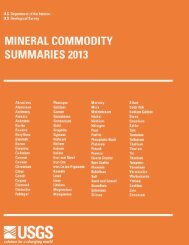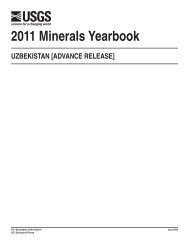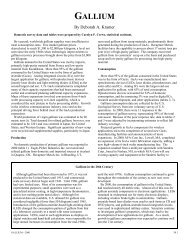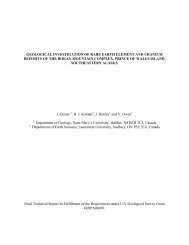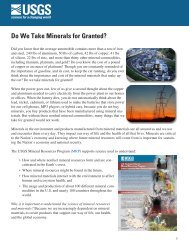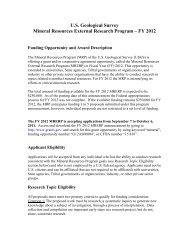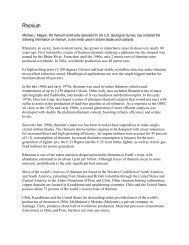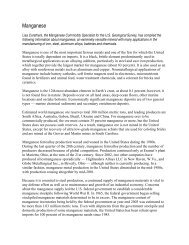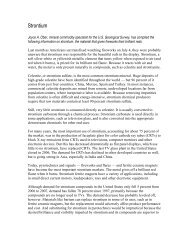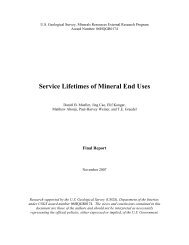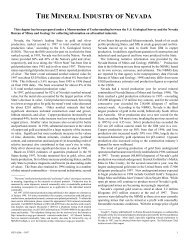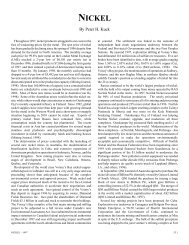Mineral Commodity Summaries 2003 - Mineral Resources Program ...
Mineral Commodity Summaries 2003 - Mineral Resources Program ...
Mineral Commodity Summaries 2003 - Mineral Resources Program ...
You also want an ePaper? Increase the reach of your titles
YUMPU automatically turns print PDFs into web optimized ePapers that Google loves.
SALT<br />
Events, Trends, and Issues: A cost/benefit analysis by a government agency in Switzerland and a university in<br />
Germany concluded that using sand as a road deicer was six times more costly than using deicing salt. Their study<br />
stated that sand, which had been assumed to be environmentally acceptable because it did not contain any salt, was<br />
more detrimental to the environment. As a result, several European cities are reducing their use of sand.<br />
Three new salt plants, two in Spain and one in Portugal, were constructed using new proprietary technology that<br />
involves hydromilling, elutriation, hydroclassification, and hydroextraction. The plants in Spain are in Súria and<br />
Cardona, and the one in Portugal is near Pombal. Salt is recovered as a byproduct from potassium chloride at the<br />
Súria facility and from a salt dome at Cardona. In Pombal, salt is obtained as brine from the solution mining of<br />
underground halite in which large cavities are developed to store natural gas.<br />
A major European salt producer announced the closure of its evaporative salt plant in Stade, Germany. The company<br />
cited overcapacity, low prices, and rising energy costs as the reasons for the closure. It had also cut back on<br />
production and employment at its other salt facility in Hengelo, Netherlands.<br />
In the Ust’-Vym district of the Komi Republic of Russia, construction began on a new $70 million salt brine and<br />
evaporative salt facility. About 350,000 tons of high-grade salt are to be produced annually from a solution mining<br />
network that uses an interconnected ten-well system.<br />
Domestic consumption of salt in <strong>2003</strong> is expected to be higher than that of 2002. However, weather forecasters<br />
indicated that the winter of 2002–03 may be relatively mild because of an El Niño weather episode developing in late<br />
2002. If this occurs, consumption of salt for highway deicing may be less than normal.<br />
World Production, Reserves, and Reserve Base:<br />
Production Reserves and reserve base 4<br />
2001 2002 e<br />
United States 1 44,800 43,900 Large. Economic and subeconomic<br />
Australia 9,500 10,000 deposits of salt are substantial in<br />
Brazil 6,000 7,000 principal salt-producing countries.<br />
Canada 12,500 13,000 The oceans contain an<br />
China 31,000 35,000 inexhaustible supply of salt.<br />
France 7,000 7,100<br />
Germany 15,700 15,700<br />
India 14,500 14,800<br />
Italy 3,600 3,600<br />
Mexico 8,900 8,700<br />
Poland 4,200 4,300<br />
Russia 2,800 3,000<br />
Spain 3,200 3,200<br />
Ukraine 2,300 2,400<br />
United Kingdom 5,800 5,800<br />
Other countries 53,200 48,000<br />
World total (may be rounded) 225,000 225,000<br />
World <strong>Resources</strong>: World resources of salt are practically unlimited. Domestic resources of rock salt and salt from<br />
brine are in the Northeast, Central Western, and southern Gulf Coast States. Saline lakes and solar evaporation salt<br />
facilities are near populated regions in the Western United States. Almost every country in the world has salt deposits<br />
or solar evaporation operations of various sizes.<br />
Substitutes: There are no economic substitutes or alternates for salt. Calcium chloride and calcium magnesium<br />
acetate, hydrochloric acid, and potassium chloride can be substituted for salt in deicing, certain chemical processes,<br />
and food flavoring, but at a higher cost.<br />
e Estimated. — Zero.<br />
1 Excludes Puerto Rico production.<br />
2 Reported stock data are incomplete. For apparent consumption and net import reliance calculations, changes in annual stock totals are assumed<br />
to be the difference between salt produced and salt sold or used.<br />
3 Defined as imports - exports + adjustments for Government and industry stock changes.<br />
4 See Appendix C for definitions.<br />
141<br />
U.S. Geological Survey, <strong>Mineral</strong> <strong>Commodity</strong> <strong>Summaries</strong>, January <strong>2003</strong>



